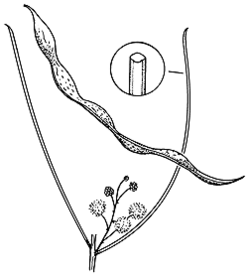Family:
Fabaceae
Acacia calamifolia
Wallowa
Other Names:

Regional Subspecies:
Occurrence:
Habit:
Upright to spreading shrub, 2-4m high with many slender branches. Has profuse golden flowers (Aug – Oct).
Habitat & Site Selection:
Footslopes and ridges. Gravelly red earth. Tolerates frost, drought and lime. Withstands short periods of waterlogging. An adaptable, hardy shrub.
Seed Collection:
Mid November to mid February. Mature seed released immediately or within 12 days of maturity. Collection may be easier if a sheet or mat is placed under the bush and the branches are shaken to release seed. The fallen pods should then be crushed and sieved to obtain seed.
Propagation:
From seed which must be scarified or heat treated prior to sowing to break the hard seed coat. Sow seed in spring (approx. 5 viable seeds per gram). Can also be grown from cuttings.
Regeneration:
Regenerates by stem coppicing after fire, also from seed.
VALUES:
Shade & Shelter:
Useful low-level cover in windbreaks.
Land Protection:
Legume, improves soil fertility by fixing nitrogen. Fast Growing.
Wildlife:
The seeds are a basic part of the diet of the rare Mallee Fowl. Food plant for caterpillars of native butterflies and moths, which in turn attract insect eating birds.
Ornamental:
Cultivated widely as ornamental. An adaptable, hardy shrub.
Other:
Bark excellent for use in tanning.
